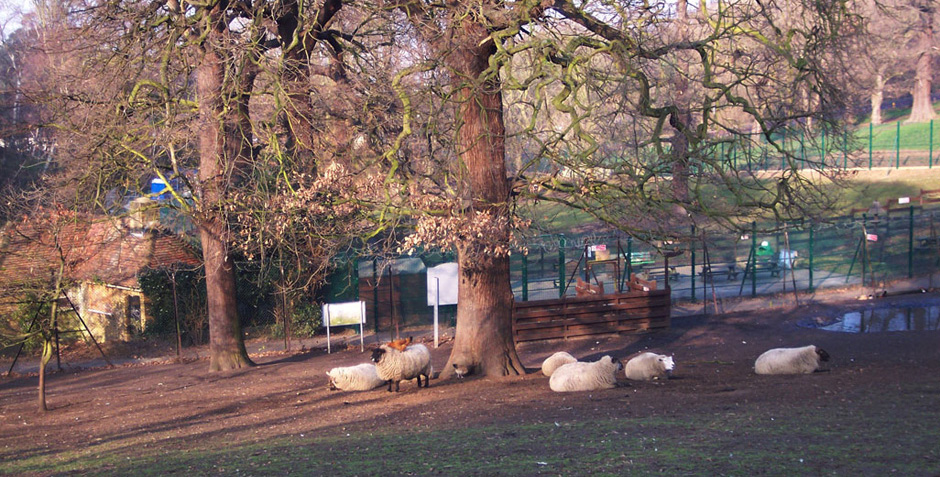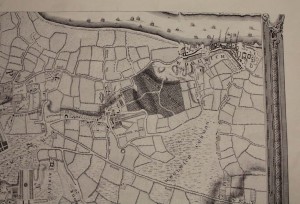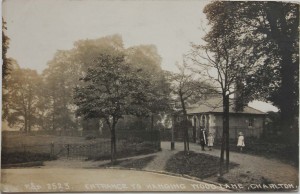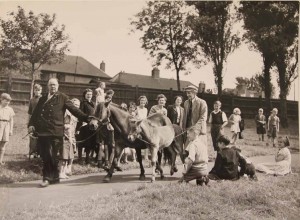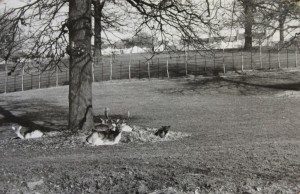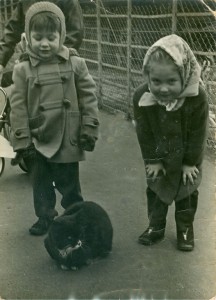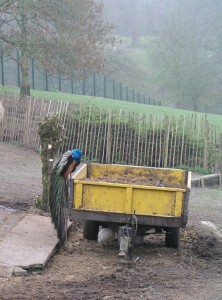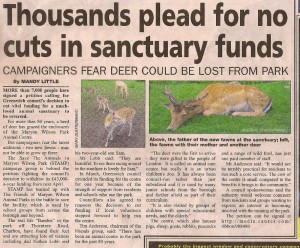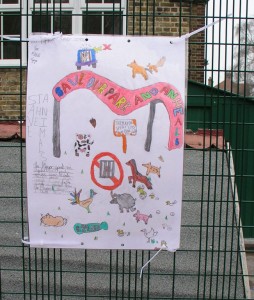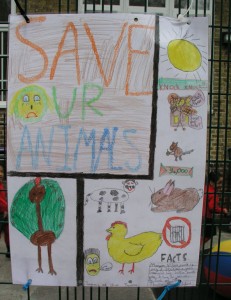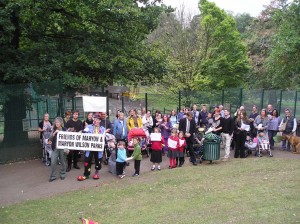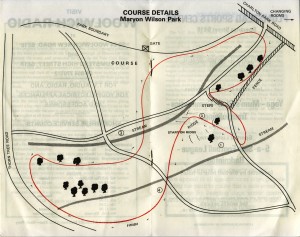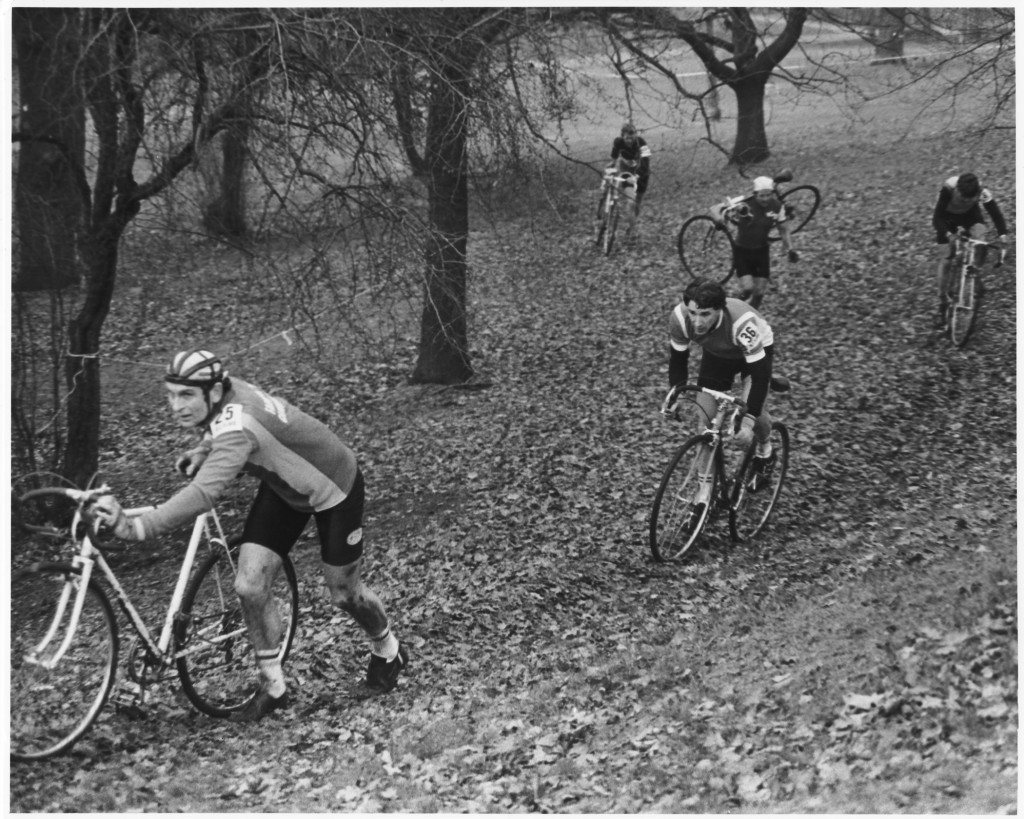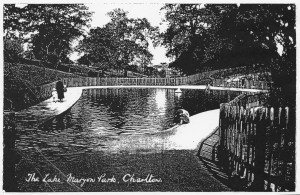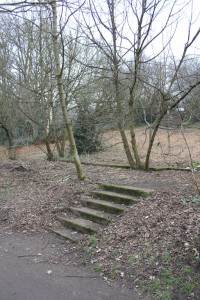Area of Interest
Maryon Wilson Park
Maryon Wilson Park comprises a remnant of what was once the ancient woodland called Hanging Wood. There are two readings of where the name derives from the main belief is the historical association with Highwaymen and footpads, being used by them as a retreat after carrying out nefarious activities at Shooters Hill and Blackheath.
A newspaper account in 1732 says: “On Sunday morning, the Reverend Mr. Richardson, who keeps school at Lewisham, going to preach at Woolwich, was attacked by a footpad in Hanging Wood, who robbed him of a guinea (leaving him but two pence) and then made off”.
The second and possible accompanying reading is that the ‘hanging’ in Hanging Wood comes from the Old English ‘hangra’, a wooded slope.
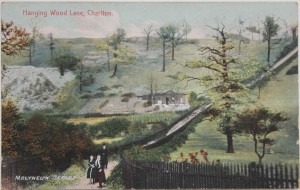
Hanging Wood and Lane, probably 1901 as the girls are in black following Queen Victoria’s death on January 22nd 1901. Greenwich Heritage Centre
Lysons in his 1796 ‘Environs of London’ writes more positively : There are in character about ninety acres of woodland called Hanging Wood, belonging to the Lord of the Manor, through which there is a very pleasant walk to Woolwich. The wood, the variety of uneven ground, and thee occasional view of the river, contribute to make the neighbourhood remarkably picturesque.”
The wood was within the manorial grounds held by the Maryon-Wilson family since 1767.
In 1912 following heavy tax demands, Sir Spencer Maryon-Wilson offered the woods to the London County Council to purchase. However this offer was not taken up. During World War I Sir Spencer made large sections of the land available for allotments and by an indenture on February 5th 1924 donated thirty two acres of Hanging Wood to the L.C.C. for the use and enjoyment of the public. This later became known as Maryon Wilson Park
The L.C.C. accepted the donation agreeing to lay out the land to retain its rural character, but including public conveniences.
The park was opened in July 1926 by Sir George Hume JP MP, chairman of the L.C.C. A few years later Sir Spencer Maryon-Wilson presented the L.C.C. with a small herd of deer.
Miss Etherington donates Exmoor ponies to Maryon Wilson Park
In 1950 a number of Exmoor ponies were donated by Miss Etherington: “Wild Horses in London. Three wild Exmoor ponies which are to live in the L.C.C. Maryon Wilson park, at Thorntree Road, Woolwich, have arrived there via King’s Cross station from Scotland. The ponies were accompanied by Miss M.G.Etherington, who has presented them to form the nucleus of a herd. These ponies are part of a herd which has been running on the Lammermuir Hills at Kidshielnugh for the past two years while the breed is studied at the Royal (Dick) Veterinary College, Edinburgh. During research into the history of the early British native horses. The Exmoor breed is believed to be the original British horse.
Text from photo of the mare ‘Aconite’ with her foal ‘Acorn’ on arrival at King’s Cross station. By kind permission of the London Metropolitan Archives.
Animals
Extract from Interview Transcript: George Burton remembers a deer retaliating
My earliest memories were the fact that there was no animals except deer. I don’t know whether people know this but they had red deer, magnificent red deer in that enclosure. The big stag there, who had been there for years and years (from what I can gather)… magnificent big one like you get in the Bambi films. His name was Bill and they called him Old Bill because he’d been there so long. As the story goes… and I couldn’t witness this but I went round there one day when there was a lot of commotion going on… and some kids or youths had got into the enclosure and started chasing the deer and he attacked them. It was soon after that they took the deer out and after a little while they brought back the fallow deer, which is much smaller and much more gentle. I don’t know… it may have been that Bill died or something and it was really just them saying, “Well, perhaps we should put the smaller deer in.” Or whether this story was true but that was the story that was handed down.
You don’t know whether the kids were actually hurt by…?
There was talk that one of them was hurt… yes. He charged them and hit them with his antlers or whatever. Yeah, yeah. Well perhaps they should have put the higher fences up or something because they were quite easy, semi-open fences that you could climb up like a ladder.
Audio Extract: Paul Tiffen describes the deer
Audio Extract: George Burton remembers a magnificent deer
Extract from Interview transcript: Linda Walker remembers making feather head dresses.
Used to go with my children – my younger son used to go to Pound Park nursery – spend a lot of time in the animal park. It was wonderful, you could just go there – you could wander around. There were various animals, more there now than then. Various birds – they used to collect feathers and make feather head dresses. They used to collect feathers, there were a lot of different birds, I think there were peacocks – just used to love going round, you could see all the various animals- a good day out, used to bring a picnic, spend an afternoon there ’cause it was such a good place to go.
Extract from Interview Transcript: Suzi Burridge remembers the deer park as a place of peace
You’d never forget Maryon Wilson Deer Park. I’ve introduced all my friends to it and I had a breakdown a couple of years ago. It was probably about five years ago now and Maryon Wilson Deer Park is part of my recovery – going there.
I wouldn’t go out. I wouldn’t interact with anybody. It was… you know, I wouldn’t change, I wouldn’t eat, I wouldn’t clean myself and then part of the road to recovery was going and sitting with the deer, looking at the deer and just remembering and feeling settled and comfortable and a sort of… you know, that warm, fuzzy feeling you get when you’re just comfortable.
I can remember, you know… it sort of reminds me of life. You know, when I had a mum and a dad and all my aunts and my uncles and when I didn’t have any worries and I didn’t have to pay bills. I didn’t have a job and you’re just a little girl. I feel like it when I go around there. I feel like a little girl. I act like a little girl as well because, you know, I end up screeching to all the animals, “Hello, hello!” And I’m waving and people think I’m absolutely barking but, yeah… I just really love it.
Bats in Maryon Wilson Park: Catherine Tongue January 2012
On Thursday September 22nd 2011 at dusk, a group of twelve or so adults and children met at the Flamsteed Road entrance to the Maryon Wilson Park. After a brief explanation from Bee Twidale (Greenwich Parks Forum) about how to use a bat detector the group set off to find out if there were bats in the park.
The first area visited was open ground looking down towards the animal enclosures with a few trees. There were very few sounds from the bat detectors, although the detectors can detect mobile phone calls and some did create some interference.
Bee explained that small bats like pipistrelles are likely to be found close to animals, where there will be a source of insect food. They are also likely to be found in wooded areas. As we walked downhill between the animal pens towards the wooded areas the detectors started to register bats. The frequencies indicated that these were pipistrelles and they could be seen flying overhead.
As it became darker the group continued with torches into the densely wooded area towards Guild Road. On the path leading down the steps the bat detectors were registering frequencies for a long period of time and pipistrelles could again be seen flying around between the trees. It was a great experience for everyone in the group. It was amazing how many bats there were and how active they were.
The walk continued down to the central path and back to the animal enclosures. As the area became more open fewer bats were detected. The walk was a most interesting event and we hope to do more walks in the summer months in 2012.
Audio Extract: Paul Tiffen remembers the ponies
Audio Extract: Paul Tiffen describes the small animals
Extract from Interview Transcript: Jill Austen takes her dog for his last walk
I’ve always used the parks. When my son was in Thorntree School we had a dog – I would always meet him from school with the dog and go to Maryon Wilson Park afterwards and he would enjoy running and climbing trees and it was just lovely to have the opportunity to let the dog run. I’ve got the saddest memory- with the dog as well – we knew that he was very poorly and taking him to the vet- we gave him his last run in Maryon Wilson Park because he just recognised it so well. We said we’ve got to let him have his last – not run – but walk there.
Audio Extract: Paul Tiffen describes a typical day with the animals
Audio Extract: John Beckham and Carol Kenna listen to 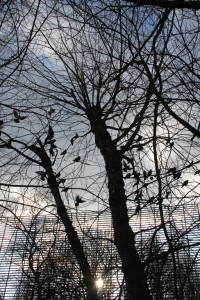 birds in Maryon Wilson Park
birds in Maryon Wilson Park
Audio: Ann Bedwell reflects on the deer park and safety
Extract from Interview Transcript: Suzi Burridge remembers walking up to the animal park
I was born at 450 Woolwich Road, as were all my family. My nan and her family and my mum and her family and most of them lived with us at 450. We were big as my cousins lived with us and my aunts and uncles. They were big properties. So Maryon Park and Maryon Wilson Deer Park were our back garden really. Maryon Wilson Deer Park was my favourite place to be and I used to go to Thorntree School as well so we used to just nip over there.
So what would you have done when you went to the park?
We would have probably started off at Woolwich Road and gone in through Maryon Park. Gone into the playground and we’d have spent time there, you know, on the swings and going from the sort of little swings to the bigger swings and being a bit daring. My favourite was the rocking horse thing that went backwards and forwards. They don’t have anything like that nowadays, do they? Nice, sort of gentle one, that just goes back and forward not up and down and tilting all over the place. I didn’t like the slides. Then there was a sort of bungalow bit where the attendants used to look out and make sure everyone was ok and must have had a first-aid bit in there. Then there was the toilets. Oh, and the merry-go-round thing as well. That was quite fun.
So we’d spend some time there and then we used to walk up and then over that bridge. There’s a little bridge there. Then you’d see the tennis courts. We used to look for the places that were in the film ‘Blow Up.’
Then there was a sort of privet hedge and then there was the great, big green which we all used to sort of sit on and have picnics. Then, another place we used to go to is past the green, just over to the left… there was the ice cream parlour place and then just round there… keep going round… there was a little secret garden and my Aunt Doris used to take me there. Me and my little sister, because it was just out of the way. Got some little seats there and lots of… they must have been roses or something but it was just nice and quiet and it was out of the way of all the people picnicking or playing ball and things like that.
Compulsory to have an ice cream, of course. Then we used those little water tap things, that we kept running backwards and forwards to ‘cause they’re just exciting to use, aren’t they, when you’re young. Then there were toilets and a little house thing just as you’re going out of that bit. So, you know, we knew it like the back of our hands. Along the other side of the big green there were seats going down and then, if you went up into the bushes, you’d go up and then over to the lovely Maryon Wilson Deer Park, which I love.
Would that have been usual? Would you have usually gone over to there or just mostly stayed in Maryon Park?
No. If we did it we probably would have done the lot. And I am just an animal person so I would naturally draw towards there to sit and to wait. Deer and sheep are fascinating to me. There were lots of little chicks and chickens as well, at some point, that used to come out of the barbed wire or whatever wire it was. They used to skip through and I remember I used to really worry about them being out and not being in their pen. I don’t really remember other – oh, the pigs. The pigs are there. The pigs have been there forever I think, and the goats. I’m not that fussed with the goats but I do go up there occasionally but the deer and the sheep are the special things, and the pigs and the little chickens. Oh, the… what are those things that bloom out?
Peacocks?
Peacocks. They’re very noisy, aren’t they? My birthday, being in June, I usually get a gang of people, we bring up our little garden chairs and take a picnic up there. I’ve done it with friends from church, done it with family. Yeah, I mean, I do just cling to the animal park mainly.
Audio Extract: Phyllis Flynn describes the animals
Campaign to keep the Animal Park in Maryon Wilson Park
Extract from Interview Transcript: Edna Anderson and Claire Mullord talk about the campaign to save the animals
(An edited audio version of this extract may be heard below)
Edna: Well, we first heard through Charlton Champion, which is a local website and then the chair of the Friends – my husband – wrote to the News Shopper and then the council saw our response and then John Fahy phoned us up and asked if he could come to our next meeting. Then he told us officially and congratulated us for finding out before they’d told us basically and then he told us that the animal park would close in April 2012 unless there was alternative funding found. So, the actual Friends of the Park didn’t actually run the campaign because there was lots of people who were in the Friends who, you know, are interested in other things, not just the animal park. Another woman called Ally actually started the campaign and I actually jumped onto that from the Friends, although the Friends kept separate from the campaign because our constitution says that we are working with the council.
So what was the first things that you thought of doing when you heard about this?
Claire: Well, as soon as I heard… it was literally in the playground. In Thorntree School playground, sort of, across the fence. A teacher telling me that the park might close. And because my daughter and my husband walked to school through it every single day it’s a big part of our lives and I was furious. I was outraged. I teach citizenship, that’s part of my job, so I’ve spent the last three years telling people how to run campaigns and do it so I just took what I teach every day and put it into practice. So the first thing I did was go onto Facebook and start a group to let people know what was happening and just to see who was out there that cared. You know, to show that we cared. It wasn’t even a petition at that point. It was just a Facebook page called a cause and people could just say ‘Yes, I support this cause of saving the animals of Maryon Wilson Park.’
So you started the Facebook and did you get an immediate response to this?
Claire: I did and it was phenomenal. It just snowballed. It went from being ten people in the first, sort of, half an hour… and in the first few days there was already hundreds of people saying they loved Maryon Wilson Park and they could comment on the animals of Maryon Wilson Park and it was really quite incredible how it just built and it made me realise that we had to do something, had to stop this from losing the funding. I wasn’t quite sure what or how but we had to do something more. And very early on Ali McGurn got in touch with me. She’s a friend of a friend. We’d never met before and she said, ‘I was about to do the same thing. Can we join forces and I’ll help you run the Facebook page and everything else.’ And that’s how met and that’s how we’ve sort of become friends… through doing that so that was great. So we did the very early stages all together which was good.
Edna: Then we invited Claire and Ali to a Friends meeting which we had at St Thomas’ Church Hall because the number of people was increasing and we couldn’t just have it in somebody’s back room. Then the paper petition was suggested because we felt that that was something that I could do in my retirement because, you know… and it would add to it because there were obviously people around who don’t go on the Internet and so Claire devised a paper petition.
Can you explain what a paper petition is?
Edna: It was basically… it said ‘Save the…’ Actually we decided to call it STAMP… Save The Animals of Maryon Park… rather than have it as part of the Friends. The idea was that we would go out to people in the community and let them know what was happening and the paper petition actually asked for the council to extend their funding after April 2012. That was what the petition was about and we let the community know that John Fahy had said that the animal park would close in April 2012. And they put their address down and their comments and who they were obviously and I can tell you some of the comments I had to say ‘I don’t think we should put this down.’ And it was very, very interesting.
So how did you collect the signatures?
Edna: Initially I started off doing house-to-house. Heathwood and Kinveachy and local ones. Then I actually went round, personally, to the eight primary schools and I went to the two special schools personally but it started to snowball and I went out into the park most days for at least an hour for six months, from April till September. I also did the Charlton football fans and other people were helping doing that as well because they were coming down in droves through the park and that was very interesting because there were a lot of the men especially had grown up in Charlton and had moved out and a lot of them would say, ‘I came here in nappies. Now I bring my grandchildren here.’ They were so supportive. On big match days we had people down at Charlton football ground as well. There was another person who lived down there, certainly up this area and she had a stall outside Charlton football ground. So, after about three or four matches, people would say, ‘I’ve signed, I’ve signed,’ as they were coming down the hill and it was just amazing.
There was… I think there was lots of support from schools, lots of support from… we did events. We did Horn Fair. Any event that was on Tim and I went to. We went to the Teddy Bears Picnic… the under-fives… got a hundred signatures there. The local churches were very, very supportive because they say, ‘You know, it’s God’s creatures.’ St Thomas and St Luke’s… both those congregations were really, really supportive. Obviously, the special schools… all the events… we took it to the Pensioner’s Forum. Pubs… the local pubs were really good, shops in the village. Basically, the local community wherever… but people were stopping me in the street and saying, ‘Can we sing the petition?’ So I ended up carrying it with me on the 53 and 380 bus basically. I was getting signatures.
So you got known as the petition lady, did you?
Edna: That’s what somebody said, ‘You’re known on the 53 bus.’ Whether it was because of that or… I don’t know.
Claire: And it’s astounding how many signatures Edna collected just being out in the park day after day.
Edna: It was great fun.
Claire: Because people…
Edna: Three and a half thousand… for that length of period. I went to Nick Rainsford as well because Thorntree Schoolwere very involved and they did a petition themselves with the children and also the Head wrote a letter but, at the end of the day, it wasn’t really up to Nick. He was very supportive and it was amazing the kind of people from the working fathers from the estate, who dropped their children… because they didn’t have a garden and they said, ‘My child learnt their first word here. You know, they learnt to say pig or sheep.’ From professors, the head of the Coptic church, doctors, musicians. Glenn Tilbrook, Bernard Ashley… you know, from the working people up… one person refused.
Only one?
Edna: One in all those and, in fact, he came back and signed. He’s now moved. He was living in Heathwood and he had a baby who was having treatment at Great Ormond Street and he felt the money should go to Great Ormond Street and I said he’d picked the wrong person. I’ve worked at Great Ormond Street and I also support it and they get a lot of funding. He came back and said, ‘I listened to you and I will sign.’ Nobody refused but it was amazing.
Audio Extract: Edna Anderson and Claire Mullord talk about the start of the campaign to save the animals
Cyclocross
The Cyclo Cross in Maryon Wilson Park was organised by Peter Haswell’s club ‘V.C. Elan’ and sponsored by Paul Mepham’s company ‘Harry Perry Cycles.’
Clubs that took part included: Addiscombe Cycling Club, Antelope Cycle Racing Club, Bexley Festival, Cycle Club, Gemini Bicycle Club, Medway Cycle Club, San Fairy Ann Cycle Club, Thanet Cycling Club, V.C. Elan / Harry Perry Cycles, Wembley Road Cycle Club, Woolwich Cycle Club, 29th Wheelers Cycling Club, 34thNomads Cycle Club.
Professional Teams that took part: Pearson Cycle Team, Raleigh Cycle Team, Chris Barber Band / Geoffrey Bulter Cycle Team, Bradford Racing Cycling Club Team.
The Cyclo Cross was sponsored by Greenwich Sports Council and Bill Fry, Greenwich Sports officer helped with the organisation.
Extract from Interveiw Transcript: Paul Mepham and Peter Haswell talk about the history of Cyclo Cross in the Park
(An edited version of the extract may be heard directly below this.)
Peter, I understand that you were involved with the Cyclo Cross in the Maryon Wilson Park right from the beginning, could you tell us a little bit about that?
Peter: Yes, I was riding for the 34th Nomads at the time and we got involved with them with Cyclo Cross and we decided to promote Cyclo Cross in London and we were the first event ever to come into London with Cyclo- Coss. I went to the British Sports Council and asked them if they could accommodate us in the area and I met with mixed response really. Originally I wanted to go to Bostall Woods and Bill Fry who was the man I was dealing with thought that was impossible and the same with Jack’s Woods at Shooters Hill. He offered me Plumstead Common, which was of no use at all to us, and finally we settled on Maryon Wilson Park which turned out to be the perfect venue. It was very hard for the riders, which was the thing in those days, where they’ve changed it now to fast road-type circuits. This was a real slog and when I first approached them in ’72 they were a bit unsure about Cyclo Cross, not knowing anything about it. But Bill Fry, he persevered with it and he gave me so much support I promised him Olympic and World championship riders from the original one… who did turn up and ride. After the first year he was so much behind it, you know, it just went from strength to strength.
Were the Nomads, were they a specialist Cyclo Cross club or were they a general cycling club?
Peter: No. They were an all round club but they had a very strong Cyclo cross team.
OK, we’ll come back to that. Paul, how did you get involved with this then?
Paul: In 1974 my wife and I took over running Harry Perry Cycles upon the death of Harry Perry and Peter approached us asking us if we would be prepared to sponsor his club, the Velo Club Elan, to which we agreed heartily, and soon after that we got involved with organising and running the Cyclo Cross in Maryon Wilson Park.
Peter: If I can just come in here. There might be a bit of confusion between the Nomads and Elan. There were four of us in the Nomads and we decided to break away from them and form the Elan, which was purely a Cyclo Cross club and that’s how we approached Paul being the local sponsor – well, the local cycle shop in the area. It seemed an ideal combination.
Could you for the sake of people who maybe aren’t familiar with Cyclo Cross, could you maybe explain or describe what it is and how the racing works?
Peter: Well it was very much a ‘come and try’ sport. You could just enter on the line and it was a combination of cycling and running. Where it got too hard to ride you’d shoulder your bike and run on these… like up steps and things, which was ideal in Maryon Wilson Park. It had something of everything there to offer the riders – fast sections and very hilly pieces.
And did you ride?
Peter: Oh, yes.
And did you ride as well?
Paul: Oh yes. Peter and I would both organise the events. A day’s racing over there would consist of maybe three or even four different categories of racing. It would obviously be the elite riders, the professionals, the top amateurs and the also-rans and then you’d have, maybe, the juniors, the schoolboys and what you could call the under-ten age group. So there would be races throughout the whole of the day starting from say ten in the morning until the major race would start about two to two-thirty and would then run for about an hour plus a lap.
Peter, how many staff or stewards did you need to run that kind of number of races?
Peter: The whole event was covered by members of the clubs in those days. Bill Fry did arrange for park-keepers to keep an eye on what was going on. He asked us just to keep away from the animal pens at the top of the course. Apart from that he give us the freedom of the circuit, you know. Each year we changed the route slightly and that’s the way we progressed through it.
Did the council charge you?
Peter: No, they supported us. They sponsored us. They gave us two trophies – The Greenwich Trophy for the main race and the Junior Trophy.
How many years did that run for then?
Peter: It’s got to be twenty years?
Paul: It was decided come 1996 to cease doing it as the structure of the VC Elan had changed to the point where we were more road racing and time trail-orientated as opposed to Cyclo Cross. A lot of those that had started in the club in the 70s and 80s had come to the end of their racing careers and, consequently, Cyclo Cross was diminishing in the club and it was decided not to run them again after 1996. Which was very sad because, personally, I thought they were a total success. We’d run a lot of championships in the park. 1983 was the Vets National Championship which is only one step down from the out-and-out National Championship and we also ran the South of England Championship as well. That was done several times, maybe as many as ten – ten years out of the twenty-odd years that we ran it there.
Peter: Actually the second year it was run under the Elan banner we had the South of England Championships on that circuit and the club won the team championship that year.
Paul: In fact, it was renowned that the Maryon Wilson circuit there was one of the most paramount events in the whole of the London League calendar. So it was always well received by riders and supporters. We would get hundreds of supporters all around the courses. You could go to another venue the following week and you’d get a man and a dog there watching it. So it was well supported both by spectators, riders and definitely by the council.
As a local resident I really miss it because I was one of those spectators who really enjoyed it.
Peter: I mean the council they supplied everything. A wagon for the seating of the judges, all the ropes and things. They couldn’t have been more helpful.
Audio Extract: Paul Mepham and Peter Haswell talk about Cyclo Cross
Leisure
Extract from Interview Transcript: May Wellard remembers playing in the 1920s.
It was just a lot of lush grass, as I can remember and trees and hawthorn is the main thing I can remember because there was so much hawthorn there. They were the bushes that you’d go tearing around…I can’t remember the games that we did chasing round and round and, of course, girls would cluster in little small groups and gossip. And a being of freedom just to run and play games…and being able to run pell-mell down a hill was a wonderful experience… another thing you could have in that park was an old wooden box on pram wheels and that could hare down…
There were no flowerbeds. It was just hills and trees. I think it’s like very much like it is now… I believe there were quite a lot of cress beds and it was really very, very marshy … I remember my sister losing her shoe because we went into the marshes and her shoe came off and couldn’t find it.
Extract from Interview Transcript: Betty and Elsie on the bread pudding jumper and the pool.
(An edited audio version version of this extract may also be heard below.)
Betty: I always remember… the one memory that sticks out with me and Maryon Wilson Park was, my mum was a great knitter and she used to have this little ‘Woman’s Weekly’ and her patterns always came out of there and we were going to the park and we woke up that morning – we could smell this lovely smell of bread pudding. She’d been up really early putting bread pudding in the oven to take with us. Got us all ready and we went down, straight to the paddling pool. And that was lovely, wasn’t it, because it was enclosed, wasn’t it? It had all bushes.
Elsie: You had nobody worrying you, did you? No.
Betty: And railings round it… and seats in there and the grass. And we went straight in the pool. We had nothing to play with, did we, but we just stayed in that pool for hours.
Elsie: Just made your own enjoyment, yeah.
Betty: Came out, had our… we was gonna have our lunch… and she just started getting the things out of her bag and she’d taken her knitting with her (as she always did) and the bread pudding had leaked. She’d only got greaseproof paper.
Elsie: Not onto the knitting?
Betty: Through to the pattern. Her knitting was alright but through to the pattern. When she opened it it was covered in grease, you know? She goes, “Oh, my pattern!” And it was all open work and from that day on that was called ‘the bread pudding jumper.’ She managed to finish it. Whenever she put it on we’d say, “Oh, the bread pudding jumper, Mum.”
Elsie: You see there are certain things that stick in your mind for ever, don’t they?
Interviewer: Whereabouts was the paddling pool?
Betty: You know as you go in? The main entrance… what we call the main entrance. The top end… Little Heath? Where all those awful trees are now. That was really, really lovely because they were all willows, weren’t they?
Elsie: Willow trees, yeah.
Betty: Beautifully kept and you could walk down and look at all the… you couldn’t walk on it. You couldn’t go on that grass but walked down, right the way down. When you got to the bottom, as it bent round a bit like that, the pool was over there, right next to the sandpit. We called it our sandpit. It wasn’t a made up sandpit. It was just a hill, wasn’t it?
Elsie: That’s right, yeah.
Audio Extract: the bread pudding jumper
Extract from Interview Transcript: May Wellard remembers picnics and paddling.
Well, we moved from Greenwich… from a two-roomed flat, with my parents and three children and we moved into this three-bedroom house, which was a council house, under the re-housing of people who needed re-housing. At that time the park was surrounded by railings but it wasn’t yet open to the public. We were able… my mother helped us over the railings onto the other side and she would hand through a jug of tea and some sandwiches. Although we had a garden it wasn’t the same. We could have a picnic in the park and I felt that it was our very own park because there was nobody else there.
As time elapsed, maybe about a month or so… it was very boggy actually, where we were… and there were lots and lots of buttercups and practically every jam jar in the house was filled with buttercups because where can you just pick flowers to your delight? Also too, eventually… I think it was 1926… that the council opened the park and I thought it was the mayor but apparently it was the MP, Sir George Hume, and he was there and there were lots of mothers and we heard that there was going to be a paddling pool there. Lots and lots of mothers and excited children and they had towels under their arms and we all… as soon as the Mayor… I can’t remember what he said but I just remember the excitement and the gate was opened and we all charged down the paths, which had already been set, and down to this paddling pool. It was an amazing experience because you’d only ever walked in water in a bath. It was so exciting but then, eventually… I can’t remember. I don’t think it was open for a very long time because there was an accident there I think and it was closed, wasn’t it?
It was about this time when all the hawthorn was out and it was absolutely fantastic and, of course, all these houses… and it was full of children just chasing around and chasing around and the mothers saying, “Be home, be home… home for tea!” “Home for bed!” And, eventually, you heard a park keeper who came, “All out, all out,” and his bell was ringing and you certainly didn’t want to be shut in the park because it was a different place at night. There were owls and so you quickly came out.
Extract from Interview Transcript: Grace Hills remembers the simplicity of playing during the War
(An edited audio version of this may also be heard below.)
You took a jam jar and you went out with it because Maryon Wilson particularly has a lot of little… probably not… still has… a lot of little streams so you went for tadpoles, tiddlers or anything like that. Girls as well as boys, you know. And, yes, quite often, shall I say, you probably took your shoes off and walked along the stream or something like that, you know. Tucked your socks in your shoes. Wiped your feet when you came out if it wasn’t hot or anything… hot enough to let them just dry on the grass… with either your handkerchief, certainly not tissues then. It was hankies, hankies or I might even be known to have done it on, you know, preferably not your skirt or dress, which would be seen when you got home but you might try wiping it on a petticoat, if you’d got a petticoat, or even sort of sliding your knickers down and doing a quick wipe and pulling them up again or something like that, you know.
Generally, just… ordinary hide and seek but as there was such a lot of trees it involved a lot of running and things like that. At least, you didn’t need to worry I think then. All right some kids might have been what would be called chubby because they were probably chubby all their lives – the family was probably like that – but you certainly didn’t hear words like obese. I don’t think I’d have even known what it meant at that time because… all right, I’m not criticising because children now can do marvellous things by looking at their own… what they’re taught at school… how to use their own databases. I mean, many of them have phones…
Audio Extract: Grace Hills remembers the simplicity of playing during the War
School children in the park
Extract from Interview Transcript: Jill Austen talks about taking school children to the park.
We still come up here a lot. Last autumn with a class – you collect so much especially this time of the year, acorns, conkers. I’m often surprised how few children are taken to the park and are familiar with the parks. They maybe walk through. I don’t think they are aware of what they are looking at. It’s a class, you talk to them and take them to a particular tree or an area and they see it in a different light. School trips provide the children with that initial introduction.
Interviewer: What are the sorts of things you might be showing kids?
It’s largely environmental – depends on the age group and what part of the curriculum you are looking at. The youngest – to look at and experience an open space – see what grows and what wildlife you can see, take things back to the classroom – fruits, nuts and fallen leaves, also experience another place that is so close but unlike the streets where they live – concrete. Our school doesn’t have a blade of grass. There’s no opportunity to sit on the grass and pull a blade of grass up. Our children especially love coming to the parks, relish it, call it a big trip, bring packed lunches even if it’s for only an hour or so.
How often do you bring them?
…When I had a reception class we decided we would make a regular termly visit to the park and photograph it at different points in the year so you would see the same tree – look at its lovely colours, looking at new growth. Same place, looks different. Sometimes it’s the emotional thing. How you are in your self. It’s different in shorts and t-shirts, different from scarves and gloves and winter coats. Try to do that each term ‘cause you could walk there. For older children, they go for other reasons. Key Stage 2 – use of open space, how it’s arranged, what’s there, the design of the playground. They design their own playground.
Features
Extract from Interview Transcript: Connie Raper remembers the ‘Pond Park’
Gran used to keep a tight hold on us, you know. But when we was allowed to go I used to go to Maryon Wilson. That’s a swing park and the other one we used to call the pond park. I suppose that was Pound Park really. Used to go and play on the swings and that. Then we used to go into the Pound… in Pound Park there’s a pond. Used to be a lovely pond. We all used to play in that pond. It was lovely. All us kids.
Was that the pond that was where the two pathways diverged in the park?
Yes. Of course, it’s not there now. It’s all overgrown now.
That’s right. I believe that’s Maryon Wilson Park and the swings were in Maryon Park.
Maryon?
Yes.
That must be it then, yes.
Did you go on your own to the park?
Oh, yes. Gran used to give us a bottle of tea or water, whatever she had there and some bread and that wrapped up in newspaper. We used to walk down the park but, before we ever got to the park, our bread and our drink had all finished… all gone. We didn’t wait to get to the park with that. It just used to go. But it was lovely when we was kids.
When we used to get into the pond the boys used to have their trousers down to their knees and so used to tuck them up and us girls used to tuck our… in our knickers… elastic. We used to call them knickers then and we used to have them tucked in our knickers. Of course, you can guess, we used to get soaking wet. I would never go out into the middle. I was too frightened of going out into the middle of the pond but the boys and all that, they used to. I’ll never forget one day we went into this pond and there was a boy come. Oh, he was so posh! He’d got a pair of swimming trunks but they’d been knitted. Of course, when he got in the water what happened? They grew. They nearly fell off of him. Of course, we all laughed at that. Funny that was.
I bet he didn’t laugh, did he?
No, poor little love. I don’t suppose he did.
Audio Extract: Ron Roffey -remembers Maryon Wilson Park in the War
Audio Extract: May Wellard remembers the park in the ’20s
All that remains of the Shelter in Maryon Wilson Park. Or perhaps it was also the site of a shop remembered as being near to the pond.
History of the Friends of Maryon Parks
The History of the Friends of Maryon Parks, Charlton by Tim Anderson, March 2012.
The Friends of Maryon Wilson Park 1980. The origins of the local community Park Friends group can be traced back to twenty years ago when ‘The Friends of Maryon Wilson Park’ were formed as a local protest pressure group. In 1980s, many local councils in London were establishing urban City Farms. Greenwich council published plans to turn Maryon Wilson Park’s historic deer enclosure and the two childrens animal zoo enclosures into an Urban Farm.
Some Local residents did not welcome this development and a local family posted flyers in the homes that surround the park to make local people aware of the council’s intentions. This lead to a small meeting, of ten or so local residents, in a Kinveachy Gardens front room where the group decided to call themselves ‘The Friends of Maryon Wilson Park’ to oppose the council’s farm.
A publicity campaign against the Urban Farm being sited in Maryon Wilson Park was organised. A local community activist, the late Grace Sole joined the group. Grace’s late husband loved the park and the children’s animal zoo and she felt passionately about preserving the park and helped to activate people, especially those who lived on the local council estates.
Objectors to the Urban Farm proposal believed it would change the nature of a beautiful natural park into a farming industry site, fearing that the grassy areas inside the three animal enclosures would become ugly muddy farming stalls. Residents were also concerned that an Urban Farm would require extra buildings and that there would be increased use of farm vehicles in the park and on local roads, with the associated risk to children. Residents also did not welcome the associated noise and smells of an Urban Farm rearing animals for meat instead of animals being cared for in a children’s zoo.
A solicitor, who joined the Friends campaign, discovered that when the Maryon-Wilson family gifted the park to the people of London in 1926, the covenant with the L.C.C. stated that the park should retain its rural nature and that apart from toilets; no additional buildings should be erected.
The Maryon-Wilson family owned Charlton House and the estate land at that time.
Further meetings were held in local homes, the local press published the story and the Friends group grew. The council eventually organised a consultation meeting about the Urban Farm proposal in the New Charlton Community Hall. The meeting was attended by hundreds of people who dramatically expressed their opposition to the council’s proposal. The council realised that the local opposition to the plan made an Urban Farm in Maryon Wilson Park non viable and started to look at alternative sites in the borough. A new site was identified on the Greenwich Peninsular, but the funds ran out and the plans for a council City Farm were dropped.
It appears that similar ‘Friends of Parks’ organisations were active in the 1980s, especially during the period of cuts in council services, as pressure groups. Councils initially regarding them as a nuisance, eventually formulated the idea of helping such groups to be constituted as council sponsored organisations of volunteers adding to the hours spent on the upkeep of the park land and helping with events in the parks.
The dichotomy between Park Friends groups as pressure groups and as voluntary add-on organisations still remains as the recent campaign to save the Maryon Wilson Animal Park illustrates.
The council sponsored Friends of Maryon and Maryon Wilson Parks was established in 2001 as a constituted local community voluntary group.
The Friends have an interest in the two parks, Maryon Park and Maryon Wilson Park and two open green spaces Gilbert’s Pit and Barrier Gardens, all in Charlton. The Friends have been active in various ways helping to care for these green spaces. The Friends have their own website, regularly clear the parks of litter, run a stall at open days, publish cards and calendars, apply for grants and keep a watchful eye on the parks. The Friends played a part in lobbying for secure fencing for the animals in Maryon Wilson Park, and established paths in a wooded area in Maryon Wilson Park. In 2012, the Friends started a Food Growing Project next to Maryon Park and gained a grant for an educational Tree Walk leaflet with an informative tree website for schools and intelligent phone applications for walkers in Maryon Wilson Park. (This can be found on the Friends website and can be downloaded from the resources section).
A new political dimension raised its head, for local people, in November 2011 when the council announced that it was withdrawing their funding from its own Animal Centre and historic deer enclosure in Maryon Wilson Park, the children’s petting zoo. Local residents formed a campaign called STAMP, Save The Animals in Maryon Wilson Park, a facebook and Internet petition were set up. Some members of the Friends became very active in the campaign collecting paper signatures. A 3,500-signature petition was submitted to the council in April 2012 and another 4,000 signatures in October 2012. One of the biggest petitions ever presented to the council.
The press and local digital media took a strong interest in the story and articles appeared in the South East London Mercury, the New Shopper, Greenwich Visitor, Westcombe Park News and even the council’s own newspaper the Greenwich Times. The local website, the Charlton Champion regularly covered the news about the Animal Park Campaign and the Chair of the Friends was interviewed on local radio about the council’s cuts.
Many school staff and parents, including people associated with Charlton (Special) School and Thorntree Junior School, the two local schools, joined in the campaign. Hundreds of Charlton Athletic F.C. fans and season ticket holders also signed the petition. The Friends wrote a day-by-day Blog on their website, reporting about the campaign. A member of the Friends came up with the idea of a ‘Buggy Protest’, parents and carers surrounding the animal enclosures with their children and buggies, as a protest against the possible closure of the animal centre. At this event, hundreds of protested turned up and the second tranche of the petition handed to the local Councillor in front of press cameras.
The council responded by first setting up a working party, to find ways of saving the Animal Centre, and then forming a limited company to enable the setting up of a Charity to run Maryon Wilson Animal Park. Members of the Friends are expected to be involved in the Charity, this time not just to volunteer help improve local parks, but this time to help save and run council amenities.
It is doubtful if members of the Friends welcome this turn of events. How the relationship between the Friends and the council and the Trust will play out only time will tell. There has been talk of the Friends becoming a single-issue political party to influence council’s parks and open spaces policy. The dichotomy between Park Friends groups as pressure groups and as voluntary add-on organizations has become even more focused than 20 years ago.

